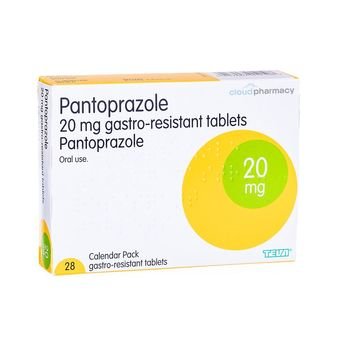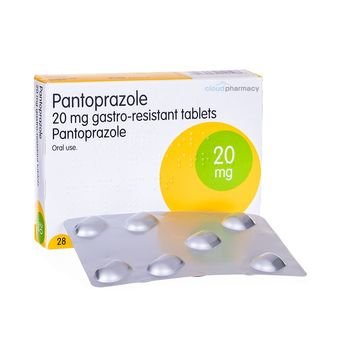Medication features
Pantoprazole is a medicine that belongs to the family of drugs known as proton pump inhibitors (PPI). It is used to treat conditions such as acid reflux, gastro-oesophageal reflux disease (GORD) and heartburn. It works by preventing certain cells within the stomach lining from producing acid. This leads to a decrease in acid refluxing up towards the respiratory tract and causing symptoms associated with all the conditions above. It is recommended that the patient take a daily dose regularly for therapeutic results to be at its most effective.
- Used to treat acid reflux and heartburn
- Provides up to 24 hours of relief
Overview
What Is Pantoprazole?
Pantoprazole is a prescription drug commonly used to treat conditions related to excess stomach acid. It can also help heal a damaged oesophagus caused by acid reflux diseases like GERD. Pantoprazole is a PPI medication. It is a class of drugs that are known as proton pump inhibitors. It relieves symptoms such as heartburn, difficulty swallowing, and persistent cough. Pantoprazole sodium is the active ingredient and is commonly sold under the brand name Protonix.
Pantoprazole is taken in the form of a tablet via the mouth. It does also come in the form of an injection and liquid mixture. So, if you struggle to swallow tablets, talk to your doctor/GP, who will be able to offer you some guidance on alternative methods.
The tablets can help you ease your symptoms within 2-3 days. The sooner you can take them, the shorter your recovery time will be.
Pantoprazole Uses
Pantoprazole treats the following conditions:
It can also be taken to treat and prevent stomach ulcers. The medication has also been used for a rare condition called Zollinger-Ellison syndrome. This is caused by the development of tumours in the gut or pancreas.
How Does Pantoprazole Work?
Pantoprazole tablets are a type of medication called a proton pump inhibitor (PPI). Proton pumps are a type of enzyme located in your stomach lining. These enzymes assist acid production, helping our body digest food. Pantoprazole tablets work by preventing these enzymes from functioning correctly. As a result, less stomach acid is produced.
Users must consume the correct dosage to allow Pantoprazole to work to its full potential. Read the product information in the medication packaging and follow your doctors' instructions. You should take one Pantoprazole tablet a day.
Pantoprazole and Alcohol
You can drink alcohol and take Pantoprazole as it does not impact its effectiveness. However, it is advised that you consult a doctor before doing so. Ideally, it would help if you approached alcohol with caution as it can increase the amount of acid your stomach produces. This worsens symptoms related to issues such as acid reflux, causing you more discomfort. Alcohol irritates your stomach lining. Talk to your doctor, who will be able to outline the risks associated with Pantoprazole and alcohol.
Is Pantoprazole Safe in Pregnancy?
If you want to treat issues like heartburn during pregnancy, Pantoprazole should be avoided. There is insufficient research to declare that Pantoprazole is safe for pregnant women. You can treat symptoms by eating smaller meals and avoiding spicy foods. If those methods do not work, consult with your doctor, who may be able to recommend an alternative treatment.
Breastfeeding mothers can take Pantoprazole tablets if their doctor/health visitor says it is safe to do so. The amount of Pantoprazole passed through breast milk is unknown. However, it is unlikely that they will experience any side effects.
Pantoprazole Alternatives
The alternatives to Pantoprazole include:
Pantoprazole vs Omeprazole
Both Pantoprazole and Omeprazole are medications that are very effective at managing acid issues and indigestion symptoms. Both of them are proton pump inhibitors (PPI). The main differences between the two come down to cost and speed.
Omeprazole works quicker than Pantoprazole. However, the effects of the medication last for a shorter length of time. This does reflect the price as Omeprazole is slightly cheaper than Pantoprazole. Additionally, the side effects of the two also differ. Pantoprazole can cause diarrhoea and headaches, while Omeprazole has a longer list of symptoms. Both medications share some similarities as both come in the form of a tablet and are also available as a liquid.
Pantoprazole vs Lansoprazole
Pantoprazole and Lansoprazole are both protein pump inhibitors effective in treating conditions related to excess stomach acids.
Both share some similarities, but they do have their differences in terms of availability and dosage. Lansoprazole is available through prescriptions and over the counter. However, Pantoprazole is prescription only. The dosage differs as Pantoprazole tablets contain 20mg or 40mg, whereas Lansoprazole tablets contain 15mg or 30mg. The side effects are also slightly different. Pantoprazole has considerably fewer side effects in comparison to Lansoprazole.
Pantoprazole Reviews
Overall, most Pantoprazole reviews are positive. Reviewers recognise that it is an effective treatment for issues such as acid reflux. Some users claim that the medication helped ease their symptoms within a few days. Another benefit that is expressed is its ease of use. As Pantoprazole is in the form of a tablet, they are easy to take.
Some reviewers did express that they encountered some mild side effects. However, the general overview is that these effects subside after a few days. Overall, Pantoprazole is recognised as an effective product for treating conditions related to excess stomach acid.
Can You Buy Pantoprazole Over the Counter?
Unfortunately, you cannot buy Pantoprazole tablets over the counter. You will need a prescription from your doctor to buy the treatment.
However, you can buy Pantoprazole tablets through Cloud Pharmacy's online pharmacy. All you need to do is complete a short online consultation beforehand. Once one of our online pharmacist prescribers has approved your consultation, the medication will be dispensed and dispatched to you in a discreet package with next-day delivery.
Directions
Pantoprazole Dosage
Each tablet will contain 20mg or 40mg of Pantoprazole. The lower dosage is recommended for those needing short-term treatment for issues such as heartburn. However, your doctor may recommend a higher dosage if your symptoms are severe. Your dosage may increase if your doctor feels the medication is not working to its full potential. It would be best if you always listened to your doctor's guidance regarding dosage. Avoid taking more Pantoprazole than you need.
How Long Does Pantoprazole Take To Work?
Pantoprazole tablets should make you feel better within 2-3 days after taking the first dose. It can take up to 4 weeks for the medication to achieve its full effect. During this time, you may still experience some symptoms. You should aim to take Pantoprazole for two weeks. If you find that your symptoms have improved during this time, your doctor will prescribe you another two weeks’ worth of treatment. If you have completed your full course of tablets and your symptoms have worsened, speak to a doctor.
How to Take Pantoprazole
We advise taking Pantoprazole treatment as soon as it is prescribed. You should take one tablet a day, preferably in the morning. Swallow the capsule as a whole, do not break, crush, or chew the medication. Take the tablet one hour before you eat your first meal. If you need to take two tablets daily, take one dose in the morning and your final one in the evening. The Pantoprazole dosage and treatment will vary depending on your health condition as well as your treatment response. Do not attempt to take more or less of the drug, use it as directed by your prescriber or as indicated in the product information leaflet.
You should swallow your Pantoprazole tablet whole and wash it down with a glass of water. If you struggle to swallow tablets, talk to your doctor/GP, who may be able to prescribe an alternative method.
If you forget to take your Pantoprazole tablet, take the missed dose as soon as you remember. If your next dose is due in the next 12 hours, skip the missed tablet and take the next one at your usual time. Avoid taking Pantoprazole at the usual dosage for more than four weeks without your doctor’s permission. If your symptoms have not improved, they may issue some further testing to get to the root cause of the issue.
Side Effects
Pantoprazole Side Effects
All medications pose some risk to their users, and Pantoprazole is no different. Users may experience some side effects when taking this treatment. Minor side effects are experienced by 1 in 100 people. Usually, these side effects are mild and will subside without needing medical assistance. Most people who take Pantoprazole will experience no side effects at all.
If you encounter the following side effects and they continue to persist, consult a doctor or pharmacist:
- Diarrhoea
- Headaches
Severe side effects can occur as a result of taking Pantoprazole. However, fewer than 1 in 1000 people report them, which is rare. If you experience any of the following symptoms, contact your doctor/GP immediately or call 999:
- Pain when you urinate: This could signify a kidney problem.
- Persistent diarrhoea: It could be signs of an inflamed bowel.
- Stomach pain that worsens along with your skin turning yellow: These signs could indicate you have a liver problem.
- Joint pain along with a red skin rash: This can happen to new and long-term users of Pantoprazole. It could signify you have a rare condition called subacute cutaneous lupus erythematosus.
It is also possible for Pantoprazole users to suffer from a severe allergic reaction (anaphylaxis) to the treatment. It is rare, and most people will not experience this. However, it is important to be aware. If you experience the following side effects, call 999 immediately:
- Chest/throat tightness
- Swelling of the mouth, lips, throat, face, and tongue
- Difficulty breathing/talking
- Red, itchy, skin rash
If you're looking to take Pantoprazole or other drugs to treat your abdominal pain or gastric health issues, speak to one of our healthcare professionals. They can discuss the drug interactions, if you're at increased risk of side effects and help you to find the right prescription drugs and other medications to help you.
Patient Information Leaflet
Pantoprazole Tablets Patient Information Leaflet
For more information on Pantoprazole tablets medication, take a look at the patient information leaflet below:
Pantoprazole FAQs
What is Acid Reflux?
It is the movement of the stomach contents up the oesophagus or gullet. Often causing an uncomfortable or burning sensation behind the breastbone.
In more serious or left untreated, Stomach contents can be regurgitated into the mouth affecting the teeth, gums and causing bad breath.
Sometimes the regurgitated fluid can enter the airways and exacerbate or make asthma worse.
What causes Acid Reflux?
The stomach has a small circular piece of muscle at the top, called the cardiac or lower oesophageal sphincter.
This stops the stomach contents from travelling back up the oesophagus or gullet.
When this muscle becomes weakened, the stomach contents can travel up and cause symptoms like heartburn, bad breath and the feeling of being sick.
Is Acid Reflux common?
It is very common and 60% of people will have reflux or similar symptoms in a 12-month period.
In the same period, 20-30% of people will have symptoms on a weekly basis.
What are the symptoms of Acid Reflux?
The movement of acid can give the following symptoms
- Burning feeling behind the breastbone
- Feeling sick
- Being sick
- Bad breath
- Tooth and gum problems
- Worsening of asthma
What can make Acid Reflux worse?
The following can make acid reflux worse.
- Being overweight or obese
- Smoking
- Eating spicy food,
- Large meal sizes
- Late night Eating, within 2 hours of going to sleep
- Alcohol
- Coffee
- Chocolate
- Pregnancy
- Tight Clothing
- Certain medicines for blood pressure like Calcium channel blockers, medicines for angina like glyceryl trinitrate and painkillers like ibuprofen, diclofenac and other anti-inflammatory drugs.
- Stress
- Genetics
How do I choose the correct treatment for Acid Reflux?
There are different categories of treatment and their uses and explanations are listed below.
Generally, patients should start with antacids and then make their way down the list if treatment does not control their symptoms.
1. Antacids – the first line treatment. These help neutralise stomach acid to relieve symptoms. The effects usually last for 2-3 hours. Examples of antacids include Rennie, Enos, Andrews Salts, and Tums. They contain ingredients like calcium carbonate, which neutralizes stomach acid, but too much calcium taken regularly can make acid reflux worse. Only be for occasional or infrequent use.
2. Alginates – neutralize and form a layer on the top of stomach acid, which prevents upward movement. Are available in tablet and liquid forms. Liquids act quicker but are more inconvenient to carry around. Usually, these last no more than 3-4 hours.
Alginates are made up of calcium carbonate, magnesium carbonate or aluminum salts. Too much calcium taken frequently can cause stomach acid to worsen, so should only be used infrequently. Excessive magnesium salts can cause diarrhoea and too much aluminum salts can cause constipation.
Always check with pharmacist, as alginates can interact with other medication. Examples include Gaviscon, Gaviscon Advance, and Peptac.
3. H2 Receptor Antagonists – available as tablets. They reduce the production of stomach acid and were initially introduced on prescription, before being available to buy from pharmacies. They start to work in as little as 30 minutes and their effects can last for up to 12 hours. They are well tolerated and side effects are rare. They can include diarrhoea, tiredness, rashes, and constipation. Examples include Ranitidine, Zantac, Gavilast, Cimetidine, and Pepcid AC.
4. Proton Pump Inhibitors – or PPIs for short, are the latest medicine for controlling acid reflux and other stomach symptoms. They work by reducing the stomach acid, but are more effective and last longer. Effects can be seen up to 17 hours after the dose is taken. They come in tablet or capsule forms, be should be swallowed whole (Losec Tablets can be crushed if needed). PPIs are very well tolerated, with low incidence of side effects. Usually, unwanted effects include diarrhoea, constipation, drowsiness. Examples include Omeprazole, Lansoprazole, Losec and Esomeprazole.
Related Guides
Delve into a variety of content written by our medical experts
Pantoprazole Reviews
Confirm Pantoprazole treatment selection
| 20mg | 14 | £14.99 |
| 20mg | 28 | £19.99 |
| 40mg | 14 | £15.99 |
| 40mg | 28 | £21.99 |
















